| #6 - Star-nosed Mole |
| Top Eleven Weirdest Mammals - Part II |
| Written by Jonathan C. Wojcik - Photo credits unknown or from public news articles unless otherwise noted. If you know their sources and need them credited or removed, please e-mail me. |
Speaking of moles, Condylura cristata is a true mole so unusual that it represents the
only member of its genus. Its trademark snout is ringed with up to 22 short, mobile
tentacles bearing up to 30,000 microscopic sensory organs, and grows in a pattern
found nowhere else in nature, peeling "banana-like" into multiple projections as the
animal matures.
only member of its genus. Its trademark snout is ringed with up to 22 short, mobile
tentacles bearing up to 30,000 microscopic sensory organs, and grows in a pattern
found nowhere else in nature, peeling "banana-like" into multiple projections as the
animal matures.
| #5 - Pangolin |
Perhaps the only mammal with a tougher exterior than the armadillos, the "scaly
anteaters" of the family Manidae are covered head to tail in razor sharp, overlapping
plates of solid keratin, the material that forms our hair and nails. When threatened, they
curl into an almost impenetrable ball of bladed armor, and when further disturbed, can
emit a noxious acid from anal glands similar to those of a skunk. Lacking teeth, they feed
exclusively on insects, particularly ants and termites, lapped up by a tongue over a foot in
length. The base of the tongue reaches as far back as the animal's chest cavity,
accompanied by an immense salivary gland to keep it effectively sticky.
anteaters" of the family Manidae are covered head to tail in razor sharp, overlapping
plates of solid keratin, the material that forms our hair and nails. When threatened, they
curl into an almost impenetrable ball of bladed armor, and when further disturbed, can
emit a noxious acid from anal glands similar to those of a skunk. Lacking teeth, they feed
exclusively on insects, particularly ants and termites, lapped up by a tongue over a foot in
length. The base of the tongue reaches as far back as the animal's chest cavity,
accompanied by an immense salivary gland to keep it effectively sticky.
| #4 - Tree Sloths |
There are six species of Sloth in the suborder Folivora, whose extinct, ground-dwelling
ancestors reached elephantine proportions. Today, the largest sloths are only a few feet
in length, and all six are strictly arboreal, spending the majority of their lives hanging
upside-down from the branches of trees. Moving only when necessary, these animals
consume whatever they find within reach and digest food at an incredibly sluggish rate,
storing it in an oversized stomach that can account for nearly two thirds of their body
weight when full. They are so adapted to their topsy-turvy perspective that their fur grows
in the opposite direction of all other mammals, pointing downward while the animal
hangs to provide better insulation against rainwater.
ancestors reached elephantine proportions. Today, the largest sloths are only a few feet
in length, and all six are strictly arboreal, spending the majority of their lives hanging
upside-down from the branches of trees. Moving only when necessary, these animals
consume whatever they find within reach and digest food at an incredibly sluggish rate,
storing it in an oversized stomach that can account for nearly two thirds of their body
weight when full. They are so adapted to their topsy-turvy perspective that their fur grows
in the opposite direction of all other mammals, pointing downward while the animal
hangs to provide better insulation against rainwater.
| #3 - The Duck-Billed Platypus |
The famous "duck bill" of this aquatic mammal is ideal for rooting worms, crayfish and
other invertebrates from muddy riverbeds, which are held captive in cheek pouches until
the animal is ready to feed. Prey is tracked by means of electroreception, a sensitivity to
electrical fields also present in the sharks and rays.
other invertebrates from muddy riverbeds, which are held captive in cheek pouches until
the animal is ready to feed. Prey is tracked by means of electroreception, a sensitivity to
electrical fields also present in the sharks and rays.
You probably knew coming in that this ridiculous beast would be high on the list. Along
with four species of Echidna, Ornithorhynchus anatinus is one of the world's only
surviving Monotremes or egg-laying mammals. Lacking teats, the female secretes milk
from simple pores (akin to sweat glands) which run along grooves in the skin to feed the
tiny offspring.
with four species of Echidna, Ornithorhynchus anatinus is one of the world's only
surviving Monotremes or egg-laying mammals. Lacking teats, the female secretes milk
from simple pores (akin to sweat glands) which run along grooves in the skin to feed the
tiny offspring.
| #1 - The Naked Mole Rat |
Looking more like a newly born "pinky" than an adult rodent, Heterocephalus glaber is
almost entirely hairless and spends its entire life underground, tunneling with its large
teeth and uncommonly powerful jaw muscles that account for roughly a quarter of their
muscle mass. To better navigate their narrow tunnels, a mole rat can turn almost
completely around in its own skin, and runs forward or backward with equal ease.
almost entirely hairless and spends its entire life underground, tunneling with its large
teeth and uncommonly powerful jaw muscles that account for roughly a quarter of their
muscle mass. To better navigate their narrow tunnels, a mole rat can turn almost
completely around in its own skin, and runs forward or backward with equal ease.
Together with the furred Damaraland mole rat, these animals are one of the world's only
eusocial vertebrates, living in colonies where a single "queen" gives birth to a sterile
worker caste. The queen is kept fertile by a harem of her own sons, and young are raised
on a diet of their older sibling's feces. Adults feed primarily on large tubers, which are
hollowed out and allowed to regrow for many years at a time.
eusocial vertebrates, living in colonies where a single "queen" gives birth to a sterile
worker caste. The queen is kept fertile by a harem of her own sons, and young are raised
on a diet of their older sibling's feces. Adults feed primarily on large tubers, which are
hollowed out and allowed to regrow for many years at a time.
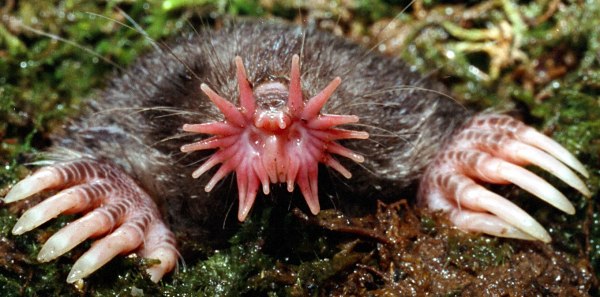
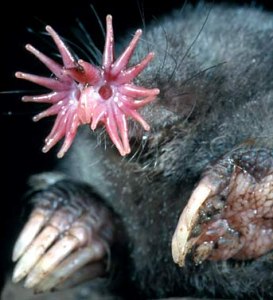
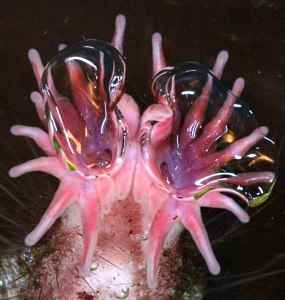
Not just an effective tunneler, the star-nosed mole is well adapted to swimming and
spends a great deal of time hunting for aquatic prey. Relying entirely on scent, it actually
smells underwater by breathing the same bubble in and out of its nose, grabbing
particles out of the water to track potential prey.
Moles feed primarily on soft-bodied invertebrates such as earthworms, which they
paralyze with a precise bite. The helpless prey may be eaten on the spot or balled up
and entombed alive for later consumption.
spends a great deal of time hunting for aquatic prey. Relying entirely on scent, it actually
smells underwater by breathing the same bubble in and out of its nose, grabbing
particles out of the water to track potential prey.
Moles feed primarily on soft-bodied invertebrates such as earthworms, which they
paralyze with a precise bite. The helpless prey may be eaten on the spot or balled up
and entombed alive for later consumption.
Though they appear quadrupedal, a pangolin's front claws are awkward for walking and
only occasionally touch the ground for balance.
only occasionally touch the ground for balance.
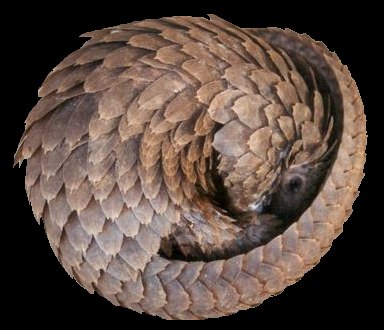
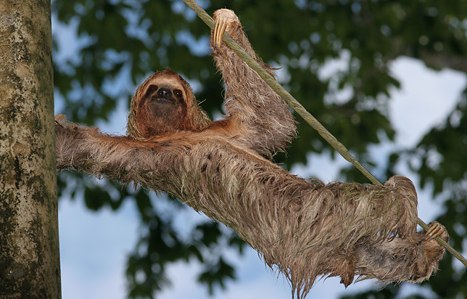
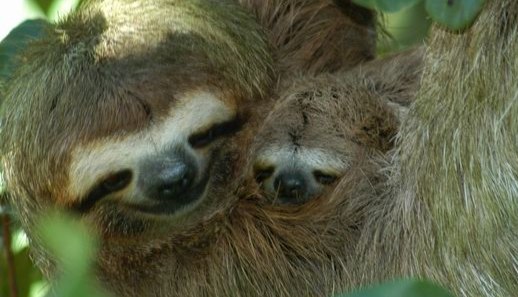
Due to their minimal activity, the bodies of sloths become an ecosystem all their own.
Symbiotic algae gives their fur a greenish tint, providing camouflage as well as
nourishment when the animals groom. This algae is in turn a food source for the adult
Cryptoses choloepi, a moth that lays its eggs exclusively in sloth excrement. Many other
microorganisms, fungi and harmless insects may colonize this lazy beast's surface,
blending it even further into the gnarled foliage of its home.
Symbiotic algae gives their fur a greenish tint, providing camouflage as well as
nourishment when the animals groom. This algae is in turn a food source for the adult
Cryptoses choloepi, a moth that lays its eggs exclusively in sloth excrement. Many other
microorganisms, fungi and harmless insects may colonize this lazy beast's surface,
blending it even further into the gnarled foliage of its home.
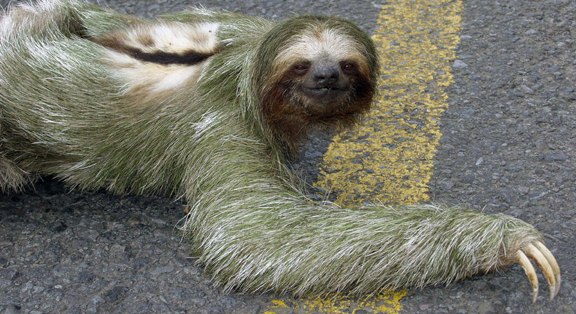
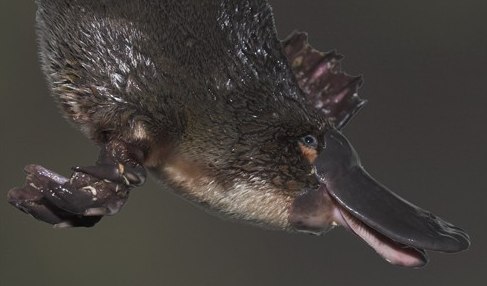
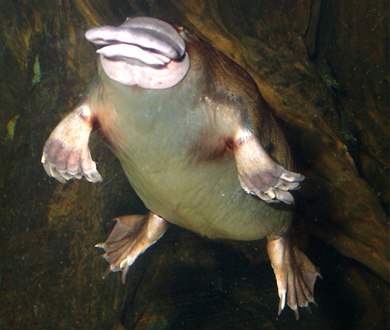
As if egg-laying, electrosense and its outlandish appearance weren't enough to stand
out, the male Platypus is one of the world's only truly venomous mammals, and one of the
only animals to deliver venom through a set of spurs on the hind legs. The sting is often
fatal to other small animals, and excrutiatingly painful for humans, who may take several
months to completely recover.
out, the male Platypus is one of the world's only truly venomous mammals, and one of the
only animals to deliver venom through a set of spurs on the hind legs. The sting is often
fatal to other small animals, and excrutiatingly painful for humans, who may take several
months to completely recover.
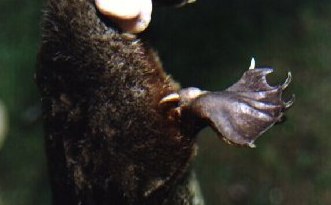
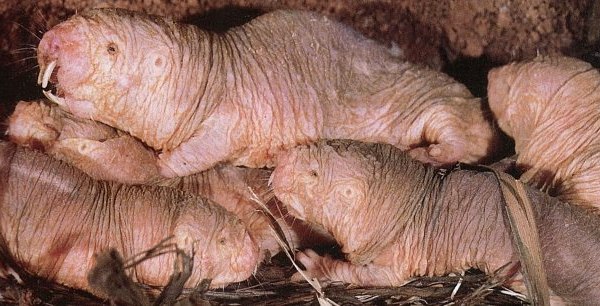
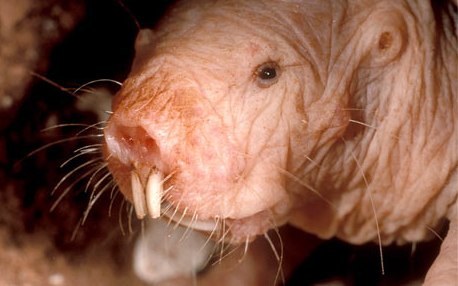
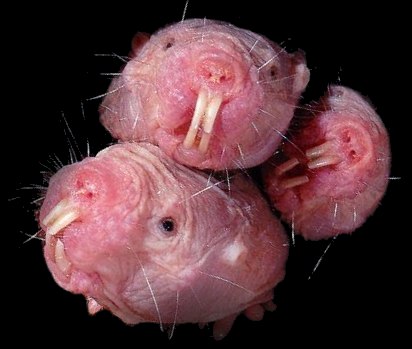
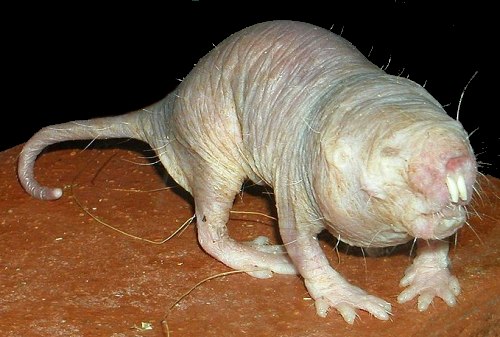
A colony of mole rats has little ventilation and builds up a high volume of carbon dioxide,
creating a toxic environment where acid can build up in living tissues. To resist these
harsh conditions, naked mole rats have adapted a very high oxygen uptake, a slow
metabolism and skin with no sensation of pain. Unable to regulate their own body
temperate, they are effectively cold-blooded mammals, and spend most of their lives
sleeping.
creating a toxic environment where acid can build up in living tissues. To resist these
harsh conditions, naked mole rats have adapted a very high oxygen uptake, a slow
metabolism and skin with no sensation of pain. Unable to regulate their own body
temperate, they are effectively cold-blooded mammals, and spend most of their lives
sleeping.
| Photos by Kenneth Catana |
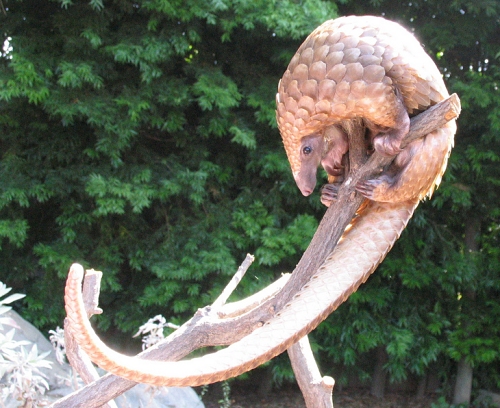
| Photo by Madflower |
| E-mail me if you know photo sources |
| E-mail me if you know photo sources |
| #2 - The Indus River Dolphin |
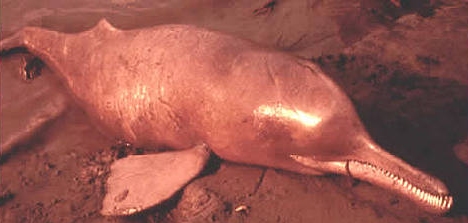
Most dolphins are famous as sea dwellers, but at least a couple species can be found in
entirely fresh-water rivers. All of these creatures are prehistoric throwbacks, retaining the
flexible necks, nearly visible fingers and elongated, crocodile-like jaws that were once
ubiquitous to whales and dolphins millions of years in the past. Teetering on the edge of
extinction, these incredibly rare animals are poorly understood, and Platanista indi, the
Indus river dolphin, may be the most mysterious of all.
These pink-skinned creatures grow to less than five feet in length, and inhabit waters so
murky that their eyes are covered over with skin. For purposes unknown, they have been
observed to swim on their sides in counter-clockwise patterns, dragging one fin along
the river bottom while emitting constant sonar clicks. Another notable mystery is their
incredibly bad breath; the blowhole is said to stink very strongly of feces. Little is known
of their mating or feeding habits, and there may be fewer than a thousand of these
kick-ass weirdos left on the planet.
entirely fresh-water rivers. All of these creatures are prehistoric throwbacks, retaining the
flexible necks, nearly visible fingers and elongated, crocodile-like jaws that were once
ubiquitous to whales and dolphins millions of years in the past. Teetering on the edge of
extinction, these incredibly rare animals are poorly understood, and Platanista indi, the
Indus river dolphin, may be the most mysterious of all.
These pink-skinned creatures grow to less than five feet in length, and inhabit waters so
murky that their eyes are covered over with skin. For purposes unknown, they have been
observed to swim on their sides in counter-clockwise patterns, dragging one fin along
the river bottom while emitting constant sonar clicks. Another notable mystery is their
incredibly bad breath; the blowhole is said to stink very strongly of feces. Little is known
of their mating or feeding habits, and there may be fewer than a thousand of these
kick-ass weirdos left on the planet.